Journey into Mandalay: The New City with an Old World Charm
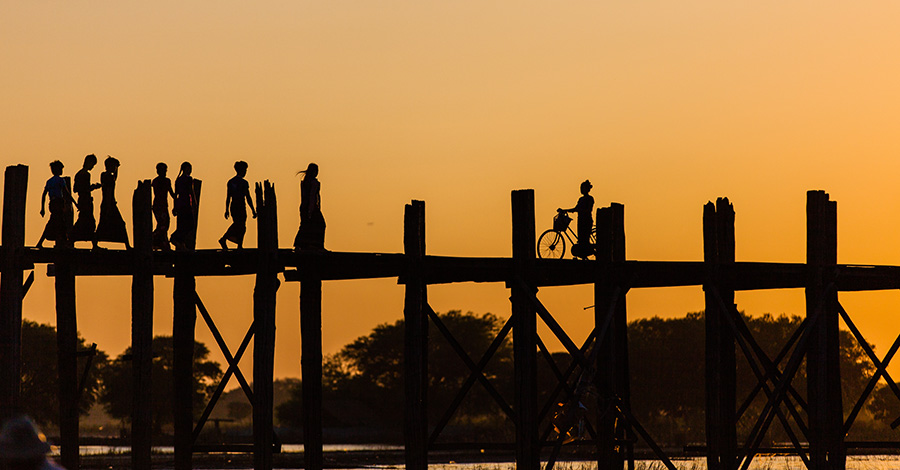
Also see: my photography tour to Myanmar.
It was a pleasant October evening, but an unusual moment when I arrived in Mandalay. Our boat docked after a long journey upstream on Ayeyarwady, throwing us immediately into chaos that we weren’t prepared for. The road from jetty to the city was clogged with people in a celebratory mood. Loud speakers–giant black boxes decked on mini-trucks–blared loud and shrieking music on a road filled with revelers dancing wildly. Chaos, crowds and cacophony had conquered the road in a way I had never seen anywhere during my journeys across Myanmar.

Sunset hour at U-Bein Bridge, Amarapura, Mandalay.
In the last leg of our week-long trip in Myanmar that had taken us through the depths of a spiritual, graceful and congenial country, we had suddenly landed into an unexpected contrast. It was the last day of Durga Puja, and much of the Indian-descents in the city had gathered by the riverside for a procession and idol immersion. We got off the car, which we had barely boarded after alighting the boat that had ferried us from Bagan, and walked into the gathered crowd. Cameras strapped around our neck, we stood out as tourists in the completely-local crowd, and caught the attention of a few revelers in no time.
We were an unusual lot in Mandalay. The city that hosts a large number of people of Indian descent gets surprisingly few tourists visiting from India. Despite being merely four hundred kilometers from Indian border and having had a shared past with India, years of isolation and military rule had insulated Myanmar from its neighbour, as much as the rest of the world.
As Myanmar opened itself up gradually over the past five years–perhaps on its way to becoming much more open after the current elections that may fuel the democratic processes–tourists have been trickling in from across the world.
The trickle is fast developing into a flood, but the number of Indian tourists is still minuscule. On my first visit to Myanmar in 2013, I saw just one visiting Indian family in a span of fifteen days. The numbers weren’t very different in 2014 and 15 either. That meant our presence among the crowd–the obvious camera-dangling-by-the-neck-tourists with obviously Indian-looking faces–did draw some attention. People came to us to talk, asked us where we are from and immediately developed a bonding. We were invited to homes and were offered every kind of assistance while we were in Mandalay.
The Burmese Indians living here were descendants of people who migrated here during the British rule, largely hailing from Bengal and Gangetic basin. The current residents just about know the names of their place or origin and very few have ever visited India. Yet, the Bollywood blockbusters that screamed from the loudspeakers indicated that they seemed to have found a way to stay in touch.
The Burmese Indian population in Mandalay is reminiscent of the city’s history associated with the British. Mandalay was under colonial rule and was an important administrative center from late nineteenth century for about six decades. But unlike Yangon–another major city under British establishment full of colonial buildings–Mandalay has little that reflects the past under occupation. Much of Mandalay’s structures are either simple, modern or Buddhist, none reflecting the high-ceilings and red-bricks of British heritage.
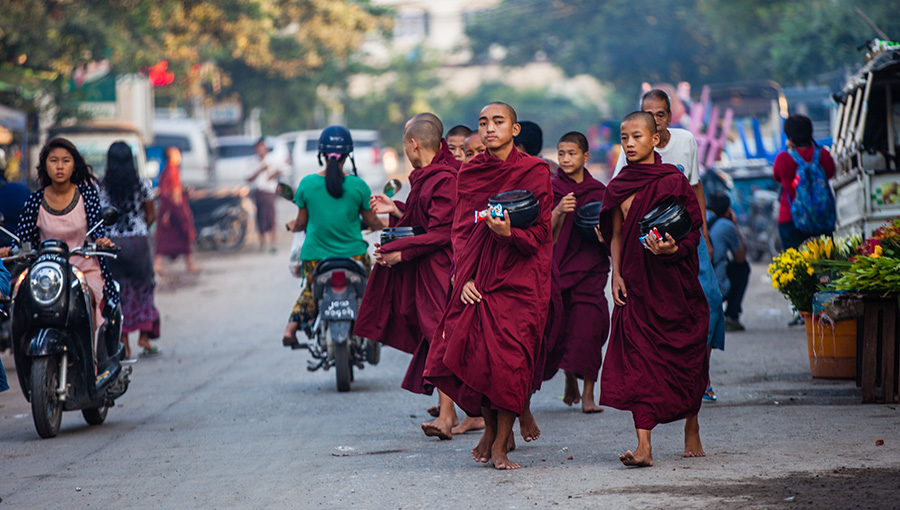
Monks walking through a busy market area in Mandalay.
Our explorations of Mandalay started very early next morning, waking up with the sun and walking along a vegetable market. The actual market was hidden deep inside a small alley, but the footpaths on the main roads leading to it were all taken by vendors during the morning hours. The entire place was busy as buyers walked in or came on tiny two-wheelers. Robed monks walked among them, sometimes coming alone, sometimes in small groups. A large group of novice monks arrived together in a truck, and they were all lovingly fed by a lady who managed a small restaurant across the street. All these activities receded once it was time for the shops to open. As the sun moved higher, an old Mandalay had given way to new.
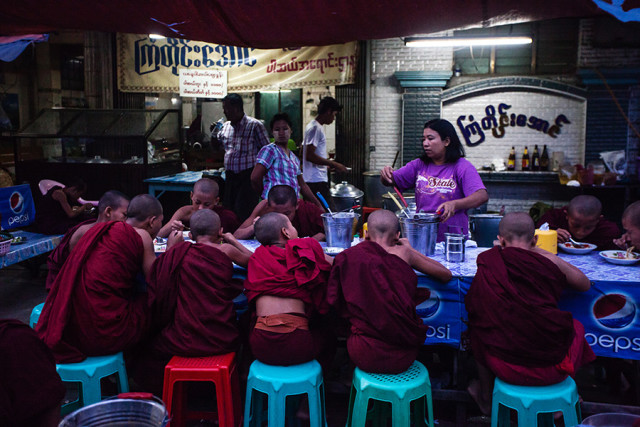 But as Mandalay moves with the flow time, it has retained a hint of all things old tucked in some of its corners. Later in the day, I visited a gold-leaf making center that uses a process that may not have changed in centuries.
But as Mandalay moves with the flow time, it has retained a hint of all things old tucked in some of its corners. Later in the day, I visited a gold-leaf making center that uses a process that may not have changed in centuries.
If you have ever travelled in South-East Asia, you would have come across people’s obsession with gold leaf. They are seen stuck extensively on Buddha idols, pagodas and other holy objects in temples and monasteries across the region. At some places, they become such a thick layer over the years that the original idol underneath would be barely visible, or even turn into a golden blob as in the case of Buddha at Phaung Daw Oo pagoda.
Returning to gold leaf making: men take thin small disks of gold and beat it all through the day with hammers until they become as thin as the edge of a sword. The process goes on all day and the ‘tonk-tonk’ sound of the hammer beaten by muscular men reverberates continuously in the workshop. The leaves have to be really thin: as much as 0.000005 inch thick (or thin, if you prefer) at the end of the process. Anything more thick is probably hard to afford! Machines would have replaced the entire process somewhere else, but the tradition hasn’t changed here in Mandalay.
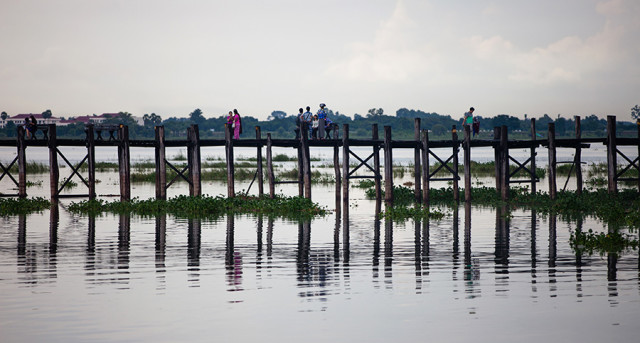 Another remnant of Mandalay’s past is U-Bein bridge, a kilometer-long teak bridge built across Taungthaman Lake near the erstwhile capital of Amarapura, at the southern edge of the city. The foot-bridge has lived for more than a century, though it has undergone several repairs over time and has even given way to a few concrete pillar in the middle. Today, the bridge’s beautiful, over-the-lake setting has turned it into a picnic destination. Young couples from Mandaly come here to spend time holding hands and chat up with a slice of watermelon or a fried crab. Monks walk back and forth – to or from their monastery in Amarapura. Cyclists, not permitted to ride on the bridge, trudge slowly pushing the two wheels.
Another remnant of Mandalay’s past is U-Bein bridge, a kilometer-long teak bridge built across Taungthaman Lake near the erstwhile capital of Amarapura, at the southern edge of the city. The foot-bridge has lived for more than a century, though it has undergone several repairs over time and has even given way to a few concrete pillar in the middle. Today, the bridge’s beautiful, over-the-lake setting has turned it into a picnic destination. Young couples from Mandaly come here to spend time holding hands and chat up with a slice of watermelon or a fried crab. Monks walk back and forth – to or from their monastery in Amarapura. Cyclists, not permitted to ride on the bridge, trudge slowly pushing the two wheels.
Come evening, tourists begin trickling in at the bridge to watch the now famed and photographed-million-times sunset across the teak pillars, hoping to capture a silhouette of bicycles or monks against the beautiful orange glow of the evening sun. Small boats carrying visitors slowly enter into the lake before the sunset-hour, creating a festive-atmosphere along the bridge.
More than a kilometer wide and nearly thrice as long, Taungthaman Lake is a water-body large and beautiful, but is dwarfed by the river that brings water to the lake – giant Ayeyarwady that flows towards the other side of Amarapura. That afternoon, I took a motor-boat across Ayeyar to visit the half-built and abandoned pagoda at Mingun.
Mingun Pagoda was conceived to be built as the largest pagoda in all of Myanmar, by virtue of which it would have also been the largest pagoda in the world. King Bodawpaya commissioned construction of the pagoda in late 18th century and abandoned the project half-way on advice from his astrologers. The incomplete structure is 50m tall and more than 100m wide. It’s scale is apparent when you set sight on it from the boat, where it stands well above the trees and other buildings. It’s the only distinctly visible structure from the other side of the river at Mandalay, nearly 10km away.
From up-close, the pagoda appears massive enough to make people next to its walls appear tiny. The huge compilation of bricks looks like a large portion of earth that has suddenly raised up like a cliff. But the days of Mingun pagoda are now numbered. An earthquake has damaged the pagoda and parts of it have fallen down, leaving large gaps in the eastern wall. A long crack that runs through the center of western face makes what could be termed as an artist’s stroke that adds immense beauty, breaking the monotony of the large structure.
Myanmar loves large pagodas. If Mingun pagoda was completed, it would be 150m tall. The tallest pagoda today stands 114m high. The well-known Shwedagon Pagoda in Yangon is just short of a hundred meters. Pagodas are also numerous all across the country: when in Myanmar you are never too far from a pagoda. You will also come across many sights where a large number of pagodas are clustered together in a small area, such as Sagaing Hill across the river from Mandalay and in the well-known ancient kingdom of Bagan.
People of Myanmar are deeply religious, which is apparent in the pagodas that get built and also in the number of monasteries that dot the country’s landscape. These monasteries come in all sizes: ones that have a handful monks to a place like Mahagandaryon Monastery near U Bein bridge with more than a thousand resident monks.
Every morning at Mahagandaryon, monks gather at a passage near the large dining hall, where they receive alms from donors and get to have their last meal of the day (monks are not permitted to eat solid foods after noon). Gathering of a thousand monks is an interesting sight, but on some days in winter months, waiting tourists may just outnumber the monks who queue up for lunch. I have seen occasional impatient tourists who tread past the permitted area for a special image and have even witnessed skirmishes for a coveted spot that offers best photography opportunities. My advice to all those impatient visitors: there is a monastery at every corner of the country; you might do better off visiting another place instead of jostling for space with so many people.
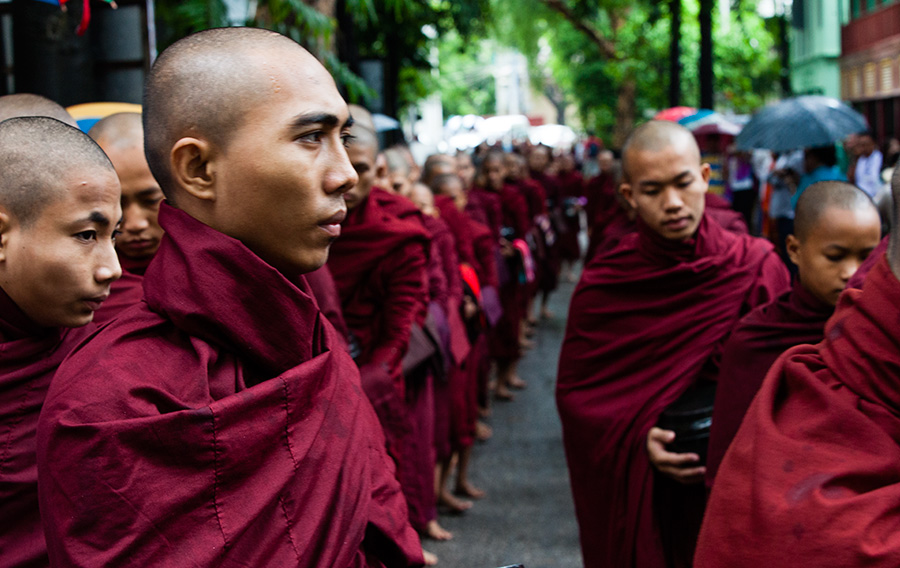
Monks at Mahagandaryon Monastery
Mahagandaryon Monastery has now seen a hundred summers since its foundation. Much of Mandalay’s old structures, including Mingun Pagoda and U-Bein bridge are all about a hundred to two-hundred years old. The city itself is very young by Burmese standard and was built in mid-nineteenth century, superseding the earlier capital at Amarapura. It came into British control in less than three decades of its creation and remained so until 1948. Decades of subsequent military rule probably leashed Mandalay from expanding and becoming a prosperous economic hub for central and northern regions of Myanmar.
But as the country opens up to rest of the world now, today’s Mandalay appears aspiring and looking forward to the good days ahead. There is an air of optimism everywhere, seen in the form of new construction, increasing vehicles on the road, shopping centers and bustling markets. Tourism is booming and more hotels are built to welcome visitors from across the world. The downtown area looks no different from a modern city anywhere in the world. Yet, there is an old world romance and a charm effusing in the corners of the city – in its monasteries, pagodas and Burma-Teak structures. And as you step out of the city towards the majestic Ayeyarwady River or the countryside to the east, the old world tropical charms jump out of Kipling’s poetry:
An’ the sunshine an’ the palm-trees an’ the tinkly Temple-bells;
On the road to Mandalay,
Where the flyin’ fishes play…
Mandalay Travel Information
Mandalay is a mid-sized city with a population of about a million people. Ayeyarwady River flows to the western edge of the city. To the northern end is Mandalay Hill, which houses a cluster of monastic buildings. Located just below the hill is Mandalay Palace. To the southern end of the city is Amarapura, the erstwhile capital, where U-Bein bridge and Mahagandaryon Monastery are located. You can travel from end-to-end of the city is less than half-an-hour.
Taxis are available for local commute, and you can also hire cars by the day. Enterprising travellers may be able to find motorcycles for hire on daily rentals.
Places to visit
U-Bein bridge: This is perhpahs Mandalay’s most well-known sight. U-Bein bridge is beautiful during sunset. The sky turning orange in the evening against the pillars of the bridge is a favourite frame for photography-enthusiasts. The best view of sunset is on a boat, and you can easily hire a boat-man at the Amarapura side of the bridge. Get on the boat at least half-an-hour before sunset; may be earlier if possible.
Mahagandaryon Monastery: Monks line up at the passage adjacent to monastery’s dining hall in the morning hours for their last meal of the day. This is usually a time when tourists visit the monastery. 10am is a good time to be there, but check with your guide or hotel for the exact time.
Mingun Pagoda: Located across Ayeyarwady River in Mingun Village, if completed, Pahtodawgyi Pagoda would have become the largest pagoda ever built and go up to a height of 150m. Construction was halted when they raised the building up to 50m. The unfinished structure is still giant and impressive. An earthquake created serious structural damages to the pagoda, but the cracks that have developed have an artistic touch that adds to the beauty of the mass of bricks.
Not far from the pagoda is Mingun Bell, one of the largest functioning bells in the world.
Small groups can hire private boats to go across the river from Mandalay to Mingun (one hour boat ride). There are pubic-transport ferries available. Check with your hotel for timings.
Sagaing Hills: Sagaing is a range of low hills across the river, connected by a bridge from Mandalay. The hills are a sacred pilgrimage destination for people of Myanmar. You will see a large number of pagodas dotting the landscape of Sagaing.
Gold Leaf Workshops: There are several gold-leaf making workshops located in down-town area, and most them are happy to take visitors. Check with your hotel for a workshop located close to where you are staying.
Mandalay Hill and Palace: Mandalay palace is a large enclosure surrounded by a moat, which forms the heart of the city. The original structure was completely damaged during World War II, and what you have now is a reconstruction. Mandalay Hill, located to the north of the palace offers you panoramic views. There are a few monasteries located on the hill, and the monks are happy to chat with visitors.
Travel to Mandalay
Mandalay is perhaps the best connected city in Myanmar after Yangon. You can reach here by bus, train, flight as well as by boats.
Boats operate only in winter months and ferry tourists everyday from Bagan. It’s a full day’s journey (about 10 hours or longer) and can get monotonous after some time.
Trains connect Mandalay from most major locations across the country. The general opinion seems to be that the trains are very slow and very uncomfortable for long rides, and you shouldn’t be on one unless you are doing it for an experience.
Buses are also available from most major locations such as Yangon, Bagan and Inle Lake region. It should be an overnight journey from Yangon or Inle Lake. and should take 4-5 hours if you are travelling from Bagan.
Several daily flights, most of them during the first half of the day, connect Mandalay with Yangon, Bagan and Heho (Inle Lake). Many airlines do a round circuit of Yangon-Bagan-Mandalay-Inle-Yangon. When you book a flight, double check on the number of stops and try to get one that gets you to your destination direct. Most airlines don’t have online booking facilities, and travel agents may not tell you how many stops your journey is unless you ask.
Mandalay also has some international connections from cities in South-East and East Asia, including Bangkok and Singapore.
